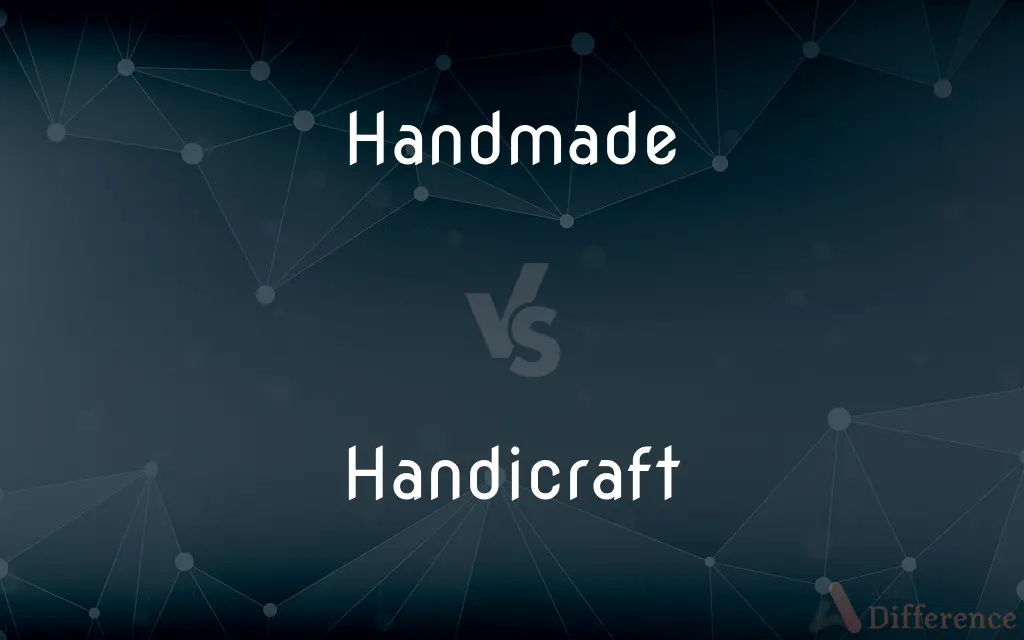Handmade vs. Handicraft — What's the Difference?
By Tayyaba Rehman & Urooj Arif — Updated on May 16, 2024
Handmade refers to items made by hand with personal skill, often without machinery, whereas handicraft denotes traditional crafts made by hand, usually reflecting cultural artistry.

Difference Between Handmade and Handicraft
Table of Contents
ADVERTISEMENT
Key Differences
Handmade items are created using manual methods, often showcasing personal skill and creativity. These items can include a wide range of products, from jewelry to furniture, emphasizing the individuality of the maker. Handicraft, on the other hand, refers to traditional crafts made by hand, often preserving cultural heritage and artistic techniques. This term typically encompasses items like pottery, weaving, and embroidery, reflecting the artisan's cultural background.
Handmade products often prioritize uniqueness and quality, highlighting the maker's personal touch in each piece. These items can be custom-made or produced in small batches, emphasizing their distinctiveness. In contrast, handicrafts are usually associated with traditional methods passed down through generations, often created in specific cultural contexts. These crafts maintain historical techniques and patterns, representing the cultural identity of the artisan.
The value of handmade items lies in their bespoke nature and the direct connection between the maker and the consumer. Buyers often appreciate the story and effort behind each piece. Handicrafts, however, hold cultural significance, preserving traditional skills and contributing to the cultural heritage of a community. These items are valued for their authenticity and historical importance.
Handmade can encompass a broader range of items, including modern and innovative designs, while handicrafts are typically more focused on traditional and cultural expressions. Both terms highlight the importance of manual skill and creativity but differ in their emphasis on personal versus cultural artistry.
Comparison Chart
Definition
Items made by hand with personal skill
Traditional crafts made by hand
ADVERTISEMENT
Emphasis
Individual creativity and uniqueness
Cultural heritage and traditional artistry
Range of Products
Broad, including modern designs
Specific to traditional and cultural items
Production Scale
Custom-made or small batches
Often produced within cultural communities
Value
Uniqueness and personal connection
Authenticity and historical significance
Compare with Definitions
Handmade
Made by hand without machinery.
The handmade necklace was crafted with intricate details.
Handicraft
Traditional crafts made by hand.
The handicraft fair featured woven baskets and embroidered fabrics.
Handmade
Unique items often custom-made.
He ordered a handmade suit tailored to his measurements.
Handicraft
Often involves techniques passed down through generations.
The village is famous for its handicraft workshops.
Handmade
Produced with individual skill and creativity.
She sells handmade pottery at the local market.
Handicraft
Reflects cultural artistry and heritage.
Handicrafts from the region are known for their vibrant colors.
Handmade
Often seen as high-quality due to personal touch.
The handmade quilt was a cherished gift.
Handicraft
Valued for authenticity and historical importance.
Handicrafts are an essential part of the cultural heritage.
Handmade
Made by hand, not by machine, and typically therefore of superior quality
His expensive handmade leather shoes
Handicraft
Represents the artisan’s cultural background.
These handicrafts preserve ancient weaving methods.
Handmade
Made or prepared by hand rather than by machine.
Handicraft
A handicraft, sometimes more precisely expressed as artisanal handicraft or handmade, is any of a wide variety of types of work where useful and decorative objects are made completely by one’s hand or by using only simple, non-automated related tools like scissors, carving implements, or hooks. It is a traditional main sector of craft making and applies to a wide range of creative and design activities that are related to making things with one's hands and skill, including work with textiles, moldable and rigid materials, paper, plant fibers,clay etc.
Handmade
Manufactured by hand.
Handmade shoes
Handicraft
Activity involving the making of decorative domestic or other objects by hand
The traditional handicrafts of this region
Handmade
An art or craft object made by hand.
Handicraft
Skill and facility with the hands.
Handmade
Manufactured by hand; as, handmade shoes. Contrasted with machine-made.
Handicraft
A craft or occupation requiring skilled use of the hands.
Handmade
Made by hand or a hand process;
Delicate handmade baby dresses
Handicraft
An object that is crafted by skilled hands.
Handmade
Crafted in small quantities.
The artisan creates handmade candles in her studio.
Handicraft
A trade requiring skill of hand; manual occupation; handcraft.
Handicraft
An artifact produced by handicraft.
Handicraft
A man who earns his living by handicraft; a handicraftsman.
Handicraft
A trade requiring skill of hand; manual occupation; handcraft.
Handicraft
A man who earns his living by handicraft; a handicraftsman.
Handicraft
A work produced by hand labor
Handicraft
A craft that requires skillful hands
Common Curiosities
Do handicrafts have more cultural value than handmade items?
Handicrafts generally have more cultural value because they preserve traditional techniques and cultural heritage.
Can modern designs be considered handicrafts?
Typically, handicrafts are traditional, but modern designs can be considered handmade if they involve manual skills.
Why are handmade items often more expensive?
Handmade items are often more expensive due to the time, skill, and individual effort involved in their creation.
What is the main difference between handmade and handicraft?
Handmade refers to items made by hand with personal skill, while handicraft denotes traditional crafts made by hand, often reflecting cultural artistry.
How do handmade items differ from mass-produced items?
Handmade items differ from mass-produced items in their unique, personalized creation process, unlike the uniformity of mass production.
Are handmade and handicraft items always unique?
Handmade items are often unique due to personal creativity, whereas handicrafts are unique in their cultural and traditional significance.
Can an item be both handmade and a handicraft?
Yes, an item can be both if it is made by hand and also reflects traditional or cultural artistry.
What materials are commonly used in handmade items?
Handmade items can be made from a wide range of materials, including wood, metal, fabric, and clay.
Can handmade items be produced in large quantities?
While handmade items can be produced in larger quantities, they are typically made in smaller batches to maintain quality.
Do handicrafts contribute to sustainable practices?
Handicrafts often contribute to sustainability by using traditional, eco-friendly methods and materials.
Is there a difference in the skill level required for handmade vs. handicraft?
Both require significant skill, but handicrafts often involve specialized techniques passed down through generations.
Are handicrafts always made from natural materials?
Handicrafts are often made from natural materials, but not exclusively; it depends on the traditional methods used.
Can handmade items be machine-assisted?
Handmade items can involve minimal machine assistance, but the primary work is done by hand.
What kind of products are typically classified as handicrafts?
Products like pottery, weaving, embroidery, and carving are commonly classified as handicrafts.
Why do people value handicrafts?
People value handicrafts for their cultural significance, authenticity, and the preservation of traditional skills.
Share Your Discovery

Previous Comparison
Honor vs. Dignity
Next Comparison
Bonus vs. StipendAuthor Spotlight
Written by
Tayyaba RehmanTayyaba Rehman is a distinguished writer, currently serving as a primary contributor to askdifference.com. As a researcher in semantics and etymology, Tayyaba's passion for the complexity of languages and their distinctions has found a perfect home on the platform. Tayyaba delves into the intricacies of language, distinguishing between commonly confused words and phrases, thereby providing clarity for readers worldwide.
Co-written by
Urooj ArifUrooj is a skilled content writer at Ask Difference, known for her exceptional ability to simplify complex topics into engaging and informative content. With a passion for research and a flair for clear, concise writing, she consistently delivers articles that resonate with our diverse audience.













































